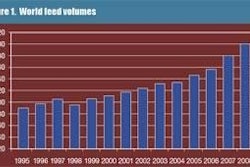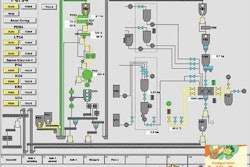In the 1970s, The Greening of America topped the bestseller lists. Fast-forward 30 years, and now the horse feed industry finds itself in its own greening process. The term "green horses" has taken on a different meaning than untrained or young stock, and it carries far more panache with today's consumers.
The question of the day is: Should the equine feed industry "go green?"
That issue was front and center at the equestrian competitions of the 2008 Summer Olympics, which touted itself as the first "Green Olympics." From environment friendly horse feeds to arena footing to recycling of stable waste, the equestrian venue last summer in Hong Kong was a model of green awareness.
During site construction, 90% of trees at the Hong Kong Sports Institute were retained in their original positions, while others were transplanted. At both the cross-country and core venues, 500 new trees and 17,000 new shrubs were planted, while fewer than 50 trees were felled. Building work inside Penfold Park was sequenced to minimize the impact on the habitat of its resident bird population of egrets during their breeding season, and energy-saving lighting systems were installed in the stabling area as well as the main and training arenas.
Impact on the environment
Clearly, greenness has firmly planted itself as an issue the animal-feed industry cannot ignore. Steve Duren of Performance Horse Nutrition has observed that horses and horse feeds have two major impacts on the environment. On the down side, Duren says, is the potential of contaminated surface and ground water from manure. On the up side, the possibility of recycling the packaging used to sell horse feed, such as feed bags. His remarks came at the 2008 Alltech International Animal Health and Nutrition Symposium in Lexington, Kentucky. Feed manufacturers, he noted, generally do not collect and reuse bags for fear of transmission of infectious diseases and potential feed contamination. That wasn't a concern for those old enough to remember bringing burlap bags back to their local feed store for grain refills, but time and awareness have obliterated that practice.
While the burden of recycling rests mainly on the consumer, Duren suggested feed manufacturers should assume responsibility for ensuring that feed bags are made of materials that can be easily recycled. But that poses economic and other challenges for the equine-feed industry, and there are no easy answers. For example, most recyclable grain bags are made of paper. But the fat content of many popular horse feeds causes them to "bleed" through paper, which damages the attractive graphics on the front of the bags and gives the appearance of an inferior product. How can the industry go green while retaining consumers' confidence? Will going green affect profitability?
In December 2008, top representatives from leading international horse feed companies Cavalor, Gain, iWest, Heemskerk, Tribute, Triple Crown, Lakeland, Western Milling, Hygain, Masterfeeds, Otter Co-op and Ritchie Feed & Seed gathered in Lexington, Kentucky, for an intensive two-day think-tank at the invitation of Alltech. The assembled companies are sponsors of the 2010 Alltech FEI Games and were gathered to discuss the concept of green horse feeds and how such products might be developed and marketed.
Alltech's Steve Elliott suggested how such products can be successfully developed and marketed, urging the feed partners to utilize their connection as sponsors to elevate global awareness of the need for green feeds. While many consider environmental friendliness an option at this point, Elliott underscored that it is "a matter of when, not if" the horse feed industry will be required to meet environmental standards.
Beyond packaging to feed
"It's not just a matter of paper bags or other packaging materials, but what goes into them," he said, pointing to supplements as an often overlooked environmental problem. Whether sold as stand-alone products in plastic containers or as ingredients in bagged grain formulations, supplements have long been an economic consideration for horse owners.
Now, the feed industry is being called upon to examine supplements in an environmental light.
Kimberly Brown, publisher and editor of The Horse, finds the issue compelling. In a recent column, she wrote: "Horse owners like feeding supplements. Some are necessary; some aren't. Those that aren't usually don't hurt our horses; the excess is merely excreted in urine or feces." But Brown noted the wider ramifications: "Those excess supplements aren't just expensive excrement; they also pollute," she wrote.
Elliott provided startling facts and figures about the effects of over-supplementation in horse feeds. A typical diet for an 1,100-pound horse in light exercise (15 pounds of alfalfa/mix hay, seven pounds of concentrate and two ounces of supplement), he said, produces the following excesses on a daily basis: protein (742 grams); calcium (51 grams); phosphorous (21 grams); copper (212 milligrams); zinc (733 milligrams); manganese (867 milligrams), and selenium (3 milligrams).
For the same horse, a "green" diet of 15 pounds of grass hay and 3 pounds of "green feed" (low protein grain, supplemented with lysine and 100% organic trace minerals, enzymes, yeast, etc.) would produce far lower excesses: protein (490 grams); calcium (34 grams); phosphorous (14 grams); copper (50 milligrams); zinc (84 milligrams); manganese (12 milligrams), and no excess selenium.
The question, then, is: How do we get there? The key steps, says Elliott, are:
- Believe the research
- Understand nutrient content of forage and availability
- Decrease nutrient content of manure
- Formulate feeds properly with available nutrients
Beyond that, the larger question remains: Will consumers spend extra dollars for an environment-friendly horse feed? Elliott is optimistic, given that they are already embracing higher-priced "green" products such as hybrid cars, light bulbs and recycled paper. Test marketing in the West has evidenced consumer interest in the concept of green horse feeds.
And in some parts of the U.S., he said, horse owners are already demanding recyclable feed bags.
To some degree, "green" feeds are already here. Triple Crown Nutrition has been using chelated minerals in its horse feeds for 15 years because it says organic sources are more efficiently utilized by the horse's body and create less waste. Its feed formulas also have a higher component than most of soluable carbohydrates, such as shredded beet pulp, which are highly bioavailable.
"Our entire focus has been to create a feed formula that would put the best nutritional value in a 50-pound bag," said Triple Crown CEO Rob Daugherty. "That philosophy drove us to create products that are bioavailable. As a result, what we did is better for the environment."
That dovetails with the company's practices with regard to grain bags. Triple Crown uses domestic packaging with soy-based inks, rather than less expensive plastic bags from overseas that use toxic inks, because vegetable-based sources are far more eco-friendly. The next step, he said, may be biodegradable bag liners.
In Daugherty's view, the concept of "green" feeds is logical. "What's healthy for the animal is also healthy for the environment. The two go hand-in-hand."


.jpg?auto=format%2Ccompress&fit=crop&h=167&q=70&w=250)












